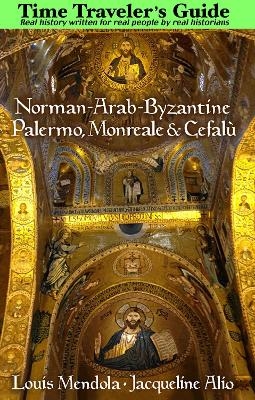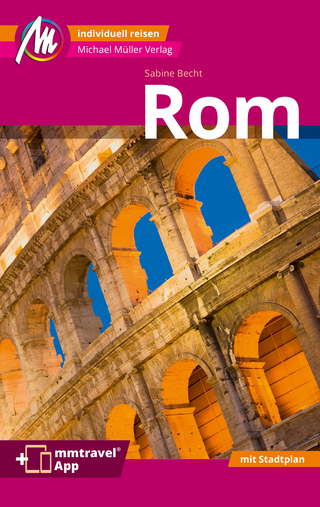
The Time Traveler's Guide to Norman-Arab-Byzantine Palermo, Monreale and Cefalù
Trinacria Editions (Verlag)
978-1-943639-13-7 (ISBN)
- Titel z.Zt. nicht lieferbar
- Versandkostenfrei innerhalb Deutschlands
- Auch auf Rechnung
- Verfügbarkeit in der Filiale vor Ort prüfen
- Artikel merken
It's the perfect book to read before you get to Sicily, and to consult when you're there.
This is the first guide written in English dedicated to the polyglot medieval heritage of three Sicilian cities where Europe met Africa and Asia for three magical centuries. Here two of Sicily's leading historians present accurate, timeless information about the Norman, Arab and Byzantine legacy of Palermo, Monreale and Cefalù. From emirs to kings, muqarnas to mosaics, this book includes details rarely published elsewhere, some drawn from the authors' original research.
Included are numerous maps and (black and white) photos. Chapters are dedicated to specific sights, such as cathedrals and castles, as well as topics like religion, architecture and the local cuisine. There are informative chapters on Fatimid art and Byzantine iconography. There is an overview of the chief period covered (900-1200), a detailed chronology, a list of important historical figures and an index, along with a concise introduction to Sicily's ancient history.
The chapters on popular sites, like Palermo's Palatine Chapel and Monreale's abbey, are detailed yet concise enough to be read quickly.
Several sites in Palermo, Monreale and Cefalù were added to the UNESCO World Heritage List in 2015. The authors describe those places and many more, including a few jewels that are generally overlooked. It's a well-kept secret that more churches standing in the twelfth century survive in Palermo than any other city in Europe.
Though it has a useful chapter on schedules, sightseeing and access, this book is not the typical destination guide that lists hotels and restaurants, perhaps providing transportation information and other details. It complements such guides (and websites) by concentrating on the kind of information that interests the slightly more curious visitor, especially the medievalist. Its emphasis is on what makes the medieval art and architecture of this corner of Sicily different from the rest of Italy and most of Europe.
The authors make the point that there's a bit of medievalist in all of us. Here the focus is the history and culture intricately interwoven into the medieval sights and sites you are visiting, or plan to visit. It's all about context and Sicily's place in the world. The authors are not travel writers but specialist historians who live in the place they write about. These pages reflect their passion.
There is an abundance of information, far more than what is found in most guides, but the lengthy index can be used as a menu. No need to read the whole book. Just choose whatever seems most interesting at the moment.
Among the book's immediately useful details are the diagrams indicating the placement of the mosaics in the churches, along with a simple genealogical chart showing how the kings and queens of the Norman era were related to each other. Equally informative are the maps of medieval Palermo.
The first few chapters of this guide, eloquently setting forth the history of the Byzantines, Arabs and Normans in Sicily, were drawn from the authors' earlier book, The Peoples of Sicily. Here is the kind of information very few guides present in a cohesive way.
This book is about more than superficial sightseeing. In describing the people and peoples behind the monuments, it invites you to embark on a journey from seeing to understanding. Along the way, you'll meet the Normans, Arabs, Greeks, Swabians and Jews who forged one of the most remarkable multicultural societies the world has ever known, something as timely as it is timeless.
This guide will transform your visit into a learning experience.
Louis Mendola is one of Sicily’s foremost medievalists, and one of the very few whose work is known beyond Italian borders. His first scholarly paper (on the Battle of Benevento of 1266) was published in 1985; others consider such topics as the history of the medieval Normans in Sicily. He wrote the first book covering the entire seven-century history of the Kingdom of Sicily, and the first English translations of two chronicles of the thirteenth century. Having researched in Italy, Britain, Spain, Germany, France and the Vatican, he has been consulted by The History Channel, the BBC and The New York Times. Read by millions internationally, his online articles have made him one of the most popular Sicilian historians of the present century. Jacqueline Alio is one of Sicily’s leading historians, and part of a new wave that is writing the history of Sicily's women. Over the last decade, she has been consulted by The History Channel, The Discovery Channel and other media. An accomplished medievalist, she has published the results of her original research while writing insightful articles for a general readership. Online, her articles have captivated millions, gaining her a special place as one of the Sicilian historians with the most readers around the world. In print, scholarly works like her translation of the Ferraris Chronicle have earned her kudos in academic circles. Margaret Queen of Sicily, the first biography of that regent, is the lengthiest published work of original scholarship written in English by a historian in Sicily. She co-authored the first book in English to outline the emerging field of Sicilian Studies. Her most recent book, the result of years of research, is a compendium of biographies of the
| Erscheinungsdatum | 01.02.2018 |
|---|---|
| Reihe/Serie | The Time Traveler's Guide |
| Verlagsort | NY |
| Sprache | englisch |
| Maße | 134 x 198 mm |
| Gewicht | 327 g |
| Themenwelt | Reisen ► Reiseberichte ► Europa |
| Reiseführer ► Europa ► Italien | |
| Geschichte ► Allgemeine Geschichte ► Mittelalter | |
| Geisteswissenschaften ► Geschichte ► Regional- / Ländergeschichte | |
| Geschichte ► Teilgebiete der Geschichte ► Kulturgeschichte | |
| ISBN-10 | 1-943639-13-2 / 1943639132 |
| ISBN-13 | 978-1-943639-13-7 / 9781943639137 |
| Zustand | Neuware |
| Haben Sie eine Frage zum Produkt? |


